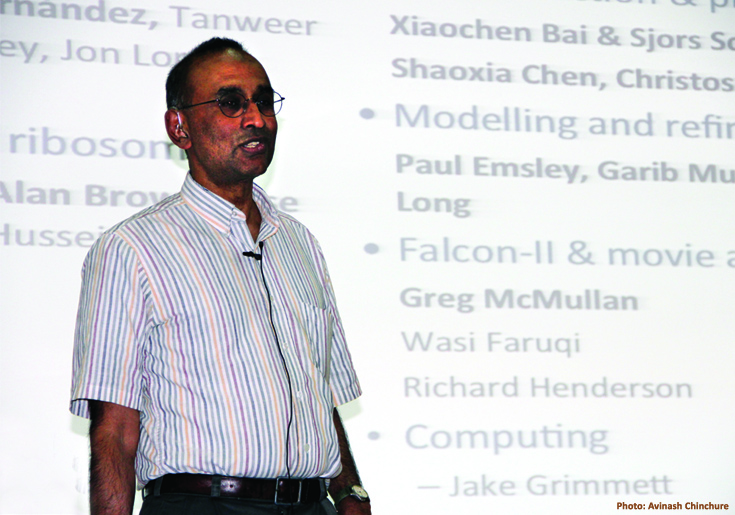Nobel Laureate Venkatraman 'Venki' Ramakrishnan speaks at NCBS
The new year at the National Centre for Biological Sciences (NCBS) kicked off with a lecture by Nobel Laureate Venkatraman Ramakrishnan on January 2nd 2014. Hosted by NCBS faculty Deepak T. Nair, Ramakrishnan's talk was part of the Golden Jubilee Celebrations of the University of Agricultural Sciences, GKVK (Bangalore). In his lecture, Ramakrishnan described recent advances in electron microscopy; the novel techniques have revolutionized the field of ribosome studies. Ribosome structure and function is an aspect Ramakrishnan and his team have been conducting path-breaking research on for several decades.
It was for his crucial work on ribosomes that Venki, as he is fondly called, was conferred the Nobel Prize in Chemistry along with Thomas A. Steitz and Ada E. Yonath in 2009. The ribosome is a cell organelle where all biological proteins required for the functioning of a living organism are synthesized. Ramakrishnan's tryst with ribsomes began in the late 1970s when he initiated studies on them with well-known chemist and biophysicist Peter Moore at Yale University. His studies led to the establishment of neutron maps that helped visualize ribosomes better. In 1998, Ramakrishnan and his colleagues developed the T7 expression system, a technique that enabled faster analysis of ribosomal structure by cloning genes responsible for the protein and overexpressing them. Structurally, ribosomes are composed of two units - a large subunit and a smaller one - both of which vary in function during protein synthesis. Ramakrishnan's most well-known contribution is the elucidation of the structure of the ribosome's smaller subunit (called the 30S) at a very high resolution. This involved obtaining crystals of the 30S subunit from heat-loving eubacteria Thermus thermophilus. His team determined the atomic structure of the 30S subunit from these crystals and also obtained a detailed list of all proteins present in it. His team has also succeeded in attaining high-resolution structures of the entire 70S bacterial ribosome. Thanks to these developments, it is now possible to locate the various spots on a ribosome to which antibiotics bind. This knowledge of antibiotics' binding sites and structures makes it easier to develop new antibiotics that could overcome resistant bacterial strains.
Decoding the structure of the ribosome has also helped better understand the several biochemical reactions that take place in the cell organelle. Ramakrishnan's work has thus opened up many possibilities to study and understand both basic science and medical research.
It is not surprising then that numerous awards, fellowships and honors have come Ramakrishnan's way. He is an elected Fellow of the Royal Society and Trinity College and has delivered many special lectures worldwide. In 2010, India honored Ramakrishnan with its second highest civilian award, the Padma Vibhushan.
Ramakrishnan currently works at the Medical Research Council Laboratory of Molecular Biology in Cambridge, England. He has actively engaged with Indian science. This talk and visit were an opportunity to broaden these interactions as well as strengthen the ongoing ties between Cambridge University and NCBS.

Comments
Post new comment